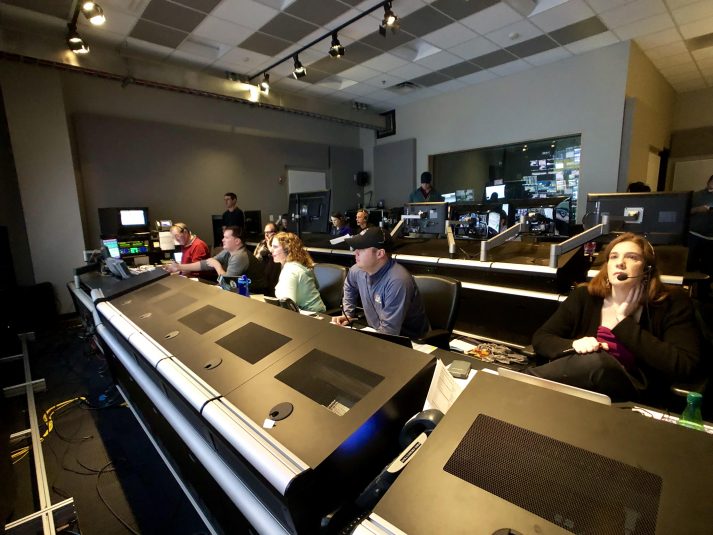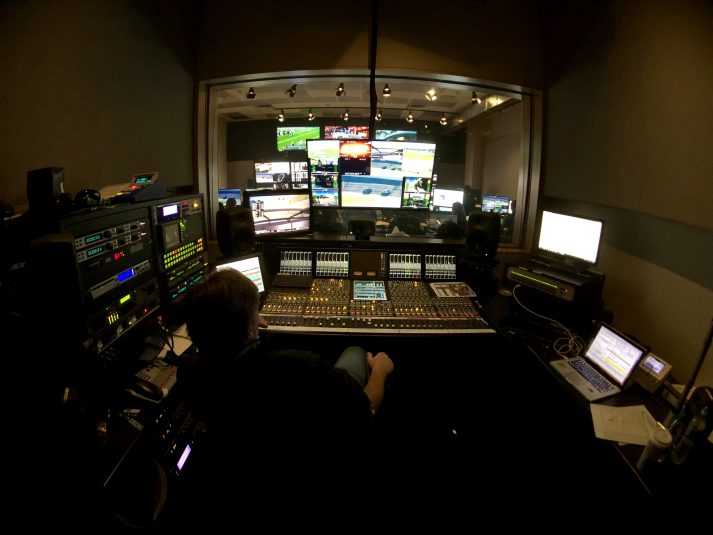NASCAR Productions Produces Rolex 24 Race Remotely from Charlotte
New NEP REMI truck, AT&T circuits plays key role in unique production effort
Story Highlights
NASCAR Productions fully embraced its concept of what it calls at home production this past weekend for the IMSA Rolex 24 endurance race at Daytona International Speedway. And with the race lasting 24 hours there are clearly benefits to be had, both in terms of cost and fatigue, to allowing most of the team to operate from their home base in Charlotte, NC. But the plan is for all of this year’s IMSA races to be produced at home, not just the Rolex 24, marking a new era for NASCAR Productions.

The NASCAR Production team produced the IMAS Rolex 24 race in Daytona remotely from Control Room 43 in Charlotte.
“NEP built a new truck for us, Alpha, that is a real remi truck with 12 cameras on it, a router, intercom, and small audio board,” says Steve Stum, NASCAR Productions, VP Operations and Technical Production. “And for future IMSA races we will also have our office space inside that truck.”
With the race lasting 24 hours the cost savings of keeping some of the team home quickly added up. The on-site team included the camera operators, about 15 technicians, and 18 talent.
“It’s a long time to do a show and do it remi is pretty bold and cutting edge for us to do,” says Stum.
A key technical enabler this season is that all of the NASCAR tracks on the IMSA circuit this year will have 10 Gbps AT&T circuits. NEP Alpha is connected to AT&T Layer 2 fiber circuits and will bring in audio and video signals from around the track and then pass them on to Charlotte where the production team will produce races from Control Room 43. A backup link from PSSI will also be in place.
“Everything is in there,” says Stum. “The pit producers, AD, graphics, SMT operations, stats and scoring data, and audio mix and sub mix.”

NEP’s Alpha production unit was designed with at home productions in mind.
Alpha comes with six Sony HDC1000 cameras, six Sony HDC1500 cameras, 12 Canon lenses, a Calrec Sigma audio console, and an Evertz EQX router. It also is wired for four 12-channel EVS units (the EVS operators for Rolex 24 were located in Charlotte working with 40 channels of EVS VIA replay servers). That team will bring in 32 camera feeds, 130 audio feeds, and with have 24 intercom channels to communicate with those on site in Daytona.
“The biggest thing is latency but with AT&T real-time fiber the roundtrip latency is only 10 milliseconds so that made a big difference as last year,” says Stum. Video is sent back over Ericsson encoders and decoders in MPEG4 with a delay of approximately 20 milliseconds. Three return feeds will be sent to the tracks via J2K.
3G Wireless provides the in-car camera systems for 14 cars with two angles per car with DTC Domo Broadcast encoders. “They do a really great job and I couldn’t be happier,” says Stum.
The 14 in-car cameras are complemented by 12 hard manned cameras, robos, a couple of POV units, and then the NBC Pit Cart down on pit road.
“Last year was a good test and this year is the next step,” says Stum. “And NBC has other ideas in the back of their mind and are fully supportive of the remi model.”
And NASCAR Productions itself will continue to look at moving different aspects of their work to an at home model. Topping the list is the in-venue videoboard show as unlike many sport venues there is not a large number of events to financially offset the costs associated with building out a top-notch video control room and videoboard system.
